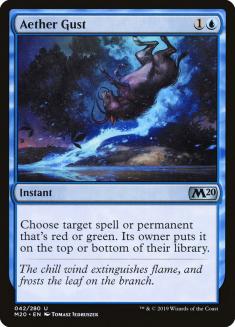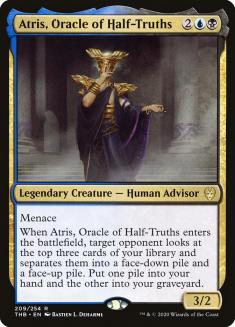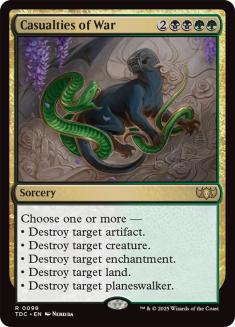Last Friday was the last day of my month-long consultation contract with Wizards of the Coast (WotC). While the experience was unbelievable, I was really excited to get back to playing Standard as the next Mythic Point Challenge was coming up. I got pretty lucky to go 10-1 in the first one with minimal preparation so I really wanted to sink my teeth into testing for the one next weekend. I started the weekend trying out Sultai Midrange variants, and asked Cedric if I could write about that deck (which he approved of).
Then things took a turn for the worse and I stopped winning with it. Like, at all. Even though I identified what I thought were the deck’s issues, I still couldn’t win after making what I considered to be good changes. “I guess it’s just a lame duck,” I said to myself, and moved onto the next deck – which I couldn’t win with either. Rinse, repeat the process, and I went through five decks this way, falling all the way back to Platinum 4 on the Arena Ladder.
Saying I was frustrated would be an understatement. Here I was, “the Standard master,” and I couldn’t even get to Platinum 1! I almost just pulled out of writing an article altogether this week, as it felt like I didn’t have anything of value to talk about with my readers. Impostor syndrome was creeping in, so I took a step back and collected my thoughts.
Eventually I realized that even though I don’t have all the answers for you now, that doesn’t mean I didn’t have something cool to offer. Today’s going to be a bit off the beaten path as we’re going to discuss what I learned from my failures with Sultai Midrange. Then we’re going to move on to the way I try to regain my balance when I’m lost in a format.
Creatures (11)
Planeswalkers (4)
Lands (22)
Spells (23)

Let’s start things off today with where it all began. While I did have access to both azureu09’s and hamuhamu’s 10-1 Mythic Invitational Qualifier lists, there were enough subtle things I wanted to do differently that I made my own list. I played around with numbers for a couple of days, but I kept running into the same problems over and over again before eventually dropping the deck.
What I Learned
What I first identified was that the deck felt too reactive and wasn’t playing to the battlefield enough. Nissa, Who Shakes the World and Hydroid Krasis are the only true proactive permanents in the deck, but they are expensive. Now don’t get me wrong, Uro, Titan of Nature’s Wrath is great and technically a creature, but it doesn’t start out as one. Outside of whatever four-drop I tried, the deck really just didn’t get things onto the battlefield.
This meant that I had to rely on my reactive cards getting me into the later turns when I didn’t draw ramp spells, but as you all know this is a pretty diverse Standard metagame right now. I thought Casualties of War would do a lot of the heavy lifting in this department, but sadly it wasn’t as good as I assumed it would be. My answers just didn’t line up at the correct times, and I’d fall behind. This caused me to continue to shift cards around trying to find the perfect combination, but what closed the door for me was realizing the deck had an even bigger issue.
These two cards are everywhere right now. Six out of the top nine decks play them. That’s insane! Even more insane is that there are nine decks in Standard that you can consider competitive, but also that six of them play blue!
If you take anything away from this article I really hope it’s this; Sultai Midrange goes against the first rule of Theros Beyond Death Standard. I’ve talked about this many times in the past, but to reiterate, your goal in Theros Beyond Death Standard is to maximize the efficiency of your interactive spells while minimizing theirs. Think about it – Atris is a four-drop that gets countered by Mystical Dispute and Casualties of War is a six-drop that gets hit by Aether Gust. There’s just too much crossover in the colors of Sultai Midrange’s spells to justify going to battle against a metagame that 66% or more of the decks play these cards.
Another big issue is that this deck also wants to play reactive cards like Aether Gust and Mystical Dispute, but it’s one of the only strategies that does so without also playing Teferi, Time Raveler. So sometimes your copies of these cards will get locked out due to your opponent’s Teferi, but you’ll never be able to do that same thing to them. This can really cause issues in games where a Teferi halves your available resources.
All of this is why I ultimately put down Sultai Midrange, but writing about it always comes with a fear that I did something wrong. After all, I’m only one person trying a finite amount of card combinations. That means there’s a very high chance that I overlooked something that you might not have so while what I did with this deck didn’t work doesn’t mean it’s a bad deck. The only thing I’ve proven is that I don’t know how to overcome these issues. If you did, please let me know.
Moving On
After I gave up on Sultai Midrange, I sort of just dabbled with decks a little, rarely getting positive results. That’s when I decided to take a step away from playing and really put in work to research the format. I looked for metagame trends, what new cards or decks people were playing, and trying to figure out why.
The first information dump I looked into was a collection of the Mythic Invitational Qualifier ten-win decks that I previously used to find the two Sultai Midrange decks I talked about earlier. While this information wasn’t complete as WotC did not release any decklists from the event themselves, I could at least extrapolate a few things from it.
Jeskai Fires was the best-performing deck with at least seven ten-win finishes that are already accounted for. After that, Temur Reclamation had at least four, and Mono-Red and Bant Ramp both had at least two. Temur Adventures wasn’t anywhere to be seen, and Azorius Control only had one top finish in the hands of control master Greg Orange.
Sometimes Magic is just random and there’s really not much you actually can do with the information. Honestly, I probably shouldn’t even try to work with this data on its own, as the sample is just too small, but there’s something I can maybe get out of it. Like I said earlier, I haven’t had a lot of time to keep up with Theros Beyond Death Standard, so I’m behind the curve. So while I shouldn’t use this data as a platform to launch from, what I can do is try to reason through why people chose the decks they did.
For example, Temur Adventures was highly played a couple weeks ago, but barely showed up this week. Already knowing this deck was good against Azorius Control and bad against Mayhem Devil strategies, I can only guess that Rakdos Sacrifice started popping up as a reaction to Temur Adventures and Uro decks. A dip in Azorius Control, and you find the perfect storm for why Temur Adventures is no longer a great deck choice. That makes sense to me and also checks out with the results of the event.
Creatures (18)
- 4 Sphinx of Foresight
- 4 Cavalier of Flame
- 3 Cavalier of Gales
- 3 Kenrith, the Returned King
- 4 Bonecrusher Giant
Planeswalkers (4)
Lands (22)
Spells (16)

So if I continue to go down this thought experiment, then I’ll eventually have to explain why Jeskai Fires was widely played with many top finishes. Seriously, what is it with this deck? I almost pulled the trigger on playing it for Mythic Championship VII, but I’ve never actually been a huge fan. It’s just always felt like a flawed strategy and I’ve never bought into the hype surrounding it.
Well, I just don’t think I can do this anymore and have to default to assuming I’m missing something. It could be in how I build it, play it, or sideboard it myself, but something I’m doing is wrong. Sure, that might not be the case, but it’s a whole lot better than continuing to have an opinion that’s disputed by results time and time again.
If I’m right about being wrong, then Jeskai Fires is just one of the best decks in the format as no deck has really ever pushed it out of the metagame. Sure it has a difficult time with Casualties of War and decks dense with countermagic like Simic Flash, but these two strategies are not great right now or even in general. The deck might also be bad against Azorius Control.
Creatures (1)
Planeswalkers (7)
Lands (14)
Spells (38)

My running theory is that Azorius Control is on the cusp of a comeback thanks to Greg’s innovative three copies of Planar Cleansing. A few weeks ago, we watched Aaron Gertler demolish multiple under-prepared Azorius Control decks with his trusty Temur Adventures deck on his way to winning DreamHack Anaheim. Greg’s new variation might just be what the archetype needed for a resurgence and it’s one that might help it a little against Jeskai Fires as well.
The changes Greg has made surely weaken the archetype against Mono-Red Aggro, but that deck seems to be on the downswing as well. Again, I don’t know this for certain, but I highly respect the Czech House players and their judgment calls.
Creatures (5)
Lands (23)
Spells (32)

I might have found a false positive here, but choosing Temur Reclamation and only playing two copies of Storm’s Wrath feels like an indicator that Mono-Red Aggro was on the decline. Of course this is speculation, but still. These players are dedicating way more time to Theros Beyond Death Standard than I’ve been able to in recent weeks, so I just have to assume this.
The Unpackening
So now we have to unpack all of this information and try to draw some conclusions.
- Jeskai Fires isn’t going anywhere.
This is an easy one. Jeskai Fires is one of the only decks to survive every metagame shift this year. It’s constantly putting up top finishes and doesn’t feel like any of its worst matchups are good enough against the field to exploit it. If I’m not able to find something deterministically better than this deck, I should invest a lot of time into mastering it for the next Mythic Point Challenge.
- Mono-Red Aggro or Azorius Control will rise again.
Odds are either Mono-Red Aggro or Azorius Control comes roaring back into the metagame. Well, Mono-Red is already very popular, but I mean more in how well it’s positioned. This really depends on how good Greg Orange’s build of Azorius Control actually is. If the archetype comes roaring back, then I could see Mono-Red Aggro continue to be a poorly positioned deck.
- Temur Reclamation goes back to being a high-risk choice.
Regardless, a target is once again on Temur Reclamation, which almost always causes the deck to go into hiding for a short bit. I’d be very surprised if this deck continues to be a Tier 1 choice.
- Bant Ramp you stay, Sultai Midrange sashay away.
Bant Ramp should be a deck I love, but it’s just okay. I think it’s good enough to challenge the format, but will never be the best choice. I can’t say the same for Sultai Midrange, but we’ve already discussed all of that. Bant Ramp still has a ton of great ways to interact with the format’s best decks, and also a slew of great removal spells for the aggressive decks in the format. Oh, and Knight of Autumn, which has taken forever to finally be good in Standard.
- Rakdos Sacrifice is a fine choice, and Jund Sacrifice is a bad one.
I get that these decks really did a number on Temur Adventures, but they were so effective that they completely pushed them out of the metagame. Now while they’re fine against the rest of the field, they always feel just slightly behind. Now I don’t think it’s so much that you can’t play them and do well; I just think they will never be the best thing you can be doing unless they exploit enemy number one.
- Temur and Simic Adventures are dead ends.
This one saddens me the most, and I hope I’m wrong about it, because I loved playing Temur Adventures. It just feels like this was a wonderful strategy until players began preparing for the matchup. Not only did they do this with adding cards to their decks like Knight of Autumn and Embereth Shieldbreaker, but also in just learning how to play against the decks. This has caused these Adventures decks to miss a step that I don’t ever see them getting back.
Ranking The Decks
- Jeskai Fires
- Bant Ramp
- Temur Reclamation
- Azorius Control
- Mono-Red Aggro
- Rakdos Sacrifice
- Temur Adventure
- Jund Sacrifice
- Sultai Midrange
I’m going to start getting in reps with Jeskai Fires starting with Mike Sigrist‘s build. While this isn’t my normal mode of operation, I don’t believe I should fight the tide forever. Many great players consistently do well with this deck so I feel like I could be one of them if I put the work in. If I struggle with it, I’ll move onto Bant Ramp, because at the end of the day we know who I am.
Given that the Mythic Point Challenge is next weekend, I’m not going to try to learn a completely new deck that I don’t already have faith in. This means I won’t be trying to play Azorius Control, Rakdos Sacrifice, or Jund Sacrifice. Everything else on the list I’ve played in major events so I feel like I can move to it if I need to.
My Goal for Next Week
This is rather ambitious, but my goal for next week’s article is to have enough knowledge in the format that I could write a sideboard primer for each deck I just said I could consider playing. If I succeed, my article’s going to be rather long. If not, then who knows, maybe the impostor syndrome gets me.
I guess we’ll find out next week!







